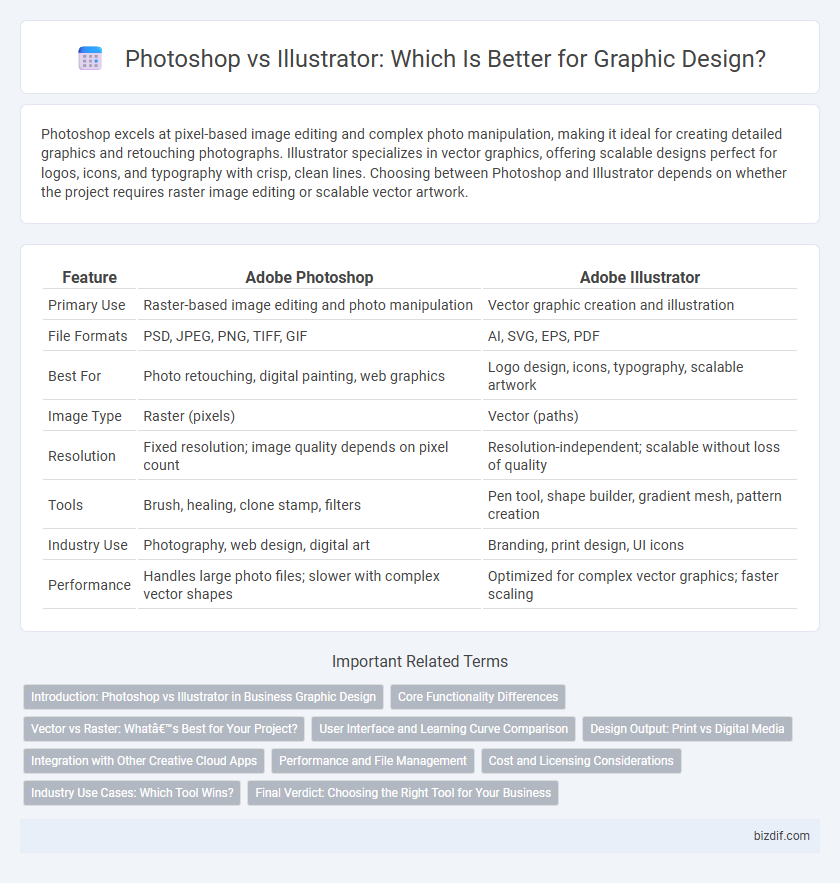Photoshop excels at pixel-based image editing and complex photo manipulation, making it ideal for creating detailed graphics and retouching photographs. Illustrator specializes in vector graphics, offering scalable designs perfect for logos, icons, and typography with crisp, clean lines. Choosing between Photoshop and Illustrator depends on whether the project requires raster image editing or scalable vector artwork.
Table of Comparison
| Feature | Adobe Photoshop | Adobe Illustrator |
|---|---|---|
| Primary Use | Raster-based image editing and photo manipulation | Vector graphic creation and illustration |
| File Formats | PSD, JPEG, PNG, TIFF, GIF | AI, SVG, EPS, PDF |
| Best For | Photo retouching, digital painting, web graphics | Logo design, icons, typography, scalable artwork |
| Image Type | Raster (pixels) | Vector (paths) |
| Resolution | Fixed resolution; image quality depends on pixel count | Resolution-independent; scalable without loss of quality |
| Tools | Brush, healing, clone stamp, filters | Pen tool, shape builder, gradient mesh, pattern creation |
| Industry Use | Photography, web design, digital art | Branding, print design, UI icons |
| Performance | Handles large photo files; slower with complex vector shapes | Optimized for complex vector graphics; faster scaling |
Introduction: Photoshop vs Illustrator in Business Graphic Design
Photoshop excels in raster-based image editing, making it ideal for detailed photo manipulation and web graphics in business branding. Illustrator specializes in vector graphics, offering scalable logos and illustrations without loss of quality, essential for print media and large-format visuals. Choosing between Photoshop and Illustrator depends on project requirements, as businesses often integrate both tools to maximize design versatility and efficiency.
Core Functionality Differences
Photoshop excels in raster-based image editing, making it ideal for photo retouching, digital painting, and complex image manipulation with pixel-level precision. Illustrator focuses on vector graphics, enabling scalable designs such as logos, icons, and typography without loss of quality. Understanding these core functionality differences is essential for selecting the right software based on project requirements in graphic design workflows.
Vector vs Raster: What’s Best for Your Project?
Photoshop excels in raster-based image editing, ideal for detailed photo retouching and complex textures, while Illustrator specializes in vector graphics, offering scalability without loss of quality for logos and illustrations. Choosing between vector and raster depends on your project's requirements: use Illustrator for designs needing infinite resizing and Photoshop for rich, pixel-based artwork. Understanding these differences ensures optimal output, preserving clarity and precision in your graphic design work.
User Interface and Learning Curve Comparison
Photoshop features a raster-based interface ideal for photo editing with layered panels and customizable toolbars, making it approachable for beginners but complex for advanced effects. Illustrator's vector-based UI emphasizes precision with anchor points and path editing, requiring more time to master detailed designs but offering scalable graphics without quality loss. Both have steep learning curves; Photoshop leans towards image manipulation skillsets, while Illustrator demands understanding of vector workflows and mathematical precision.
Design Output: Print vs Digital Media
Photoshop excels in raster-based image editing ideal for detailed digital artwork and photo manipulation, making it perfect for digital media projects such as web graphics and social media content. Illustrator specializes in vector graphics, enabling scalable designs without loss of quality, which is essential for print materials like logos, brochures, and posters. Choosing between Photoshop and Illustrator depends on the design output requirements: pixel-based for digital media or resolution-independent vectors for high-quality print production.
Integration with Other Creative Cloud Apps
Photoshop seamlessly integrates with Adobe Lightroom for advanced photo editing workflows, while Illustrator offers superior connectivity with Adobe InDesign for precise vector-based layout designs. Both applications support exchange with Adobe After Effects, enhancing motion graphics development through layered file compatibility. This integration streamlines the creative process, ensuring designers maintain high fidelity across diverse media projects.
Performance and File Management
Photoshop excels in handling pixel-based images with high-performance editing tools optimized for detailed photo retouching, while Illustrator delivers superior performance in managing vector graphics that scale seamlessly without loss of quality. Photoshop files (PSD) can become large and complex due to multiple layers and raster effects, often requiring more storage and memory, whereas Illustrator's AI files remain relatively lightweight and easier to manage because they store mathematical vector data. Efficient file management in Illustrator supports faster loading times and simpler edits for logos and illustrations, contrasting with Photoshop's robust capacity for intricate image manipulation but heavier file overhead.
Cost and Licensing Considerations
Photoshop and Illustrator both require Adobe Creative Cloud subscriptions, but Photoshop is available in standalone plans starting at $20.99 per month, while Illustrator also starts at $20.99 monthly with options for bundle packages including both apps. Licensing costs vary depending on whether users opt for individual, business, or educational plans, influencing the overall investment based on intended use and user type.
Industry Use Cases: Which Tool Wins?
Photoshop excels in photo editing, digital painting, and raster-based design tasks, making it the industry standard for photographers, web designers, and digital artists. Illustrator, built around vector graphics, dominates logo creation, typography, and scalable illustrations, preferred by branding agencies and packaging designers. In corporate environments, both tools often complement each other, but Illustrator's precision and scalability give it the edge for print media and detailed graphic work.
Final Verdict: Choosing the Right Tool for Your Business
Photoshop excels in pixel-based image editing, making it ideal for photo retouching and detailed raster graphics, while Illustrator specializes in scalable vector designs perfect for logos and branding materials. Businesses prioritizing web design, digital art, or photography benefit from Photoshop's extensive toolkit, whereas those focused on print media, icon creation, and scalable graphics gain more value from Illustrator's precision. Selecting the right software depends on project requirements, asset types, and the desired output format to maximize efficiency and quality.
Photoshop vs Illustrator Infographic

 bizdif.com
bizdif.com